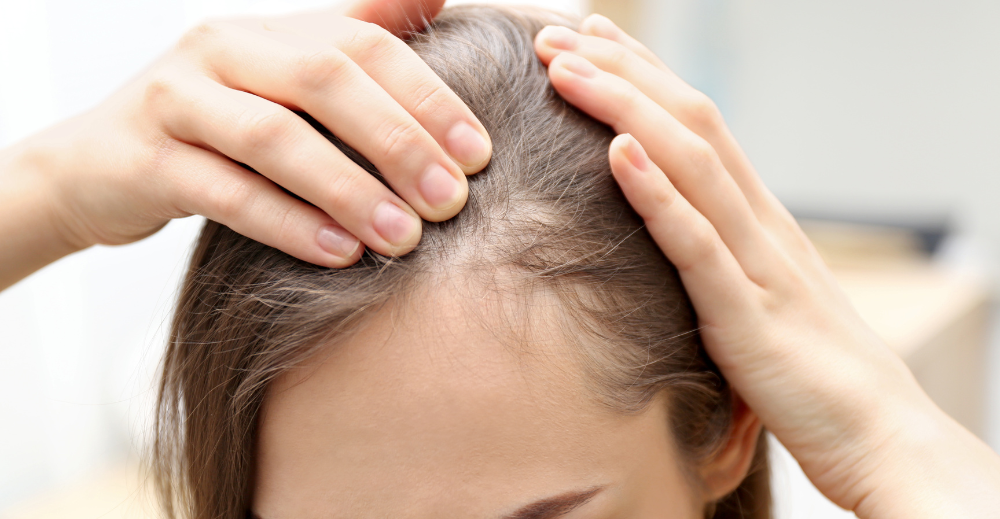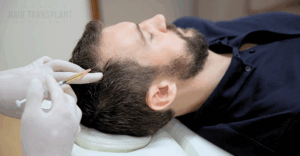Hair loss in women can be a distressing experience, impacting self-esteem and confidence. However, there are a wide range of treatment options available today, tailored to the underlying causes of hair loss. Whether it’s a hormonal imbalance or nutritional deficiency, finding the right solution can help women regain their hair and confidence. In this article, we will explore the various treatments for women’s hair loss, from over-the-counter solutions to more advanced therapies.
Understanding the Causes of Hair Loss in Women
Before diving into treatment options, let’s just hit a quick refresher on why hair loss happens. Hair loss in women can stem from various factors, including genetics, hormonal imbalances, and stress. Some of the common causes include:
• Androgenetic Alopecia: The most common cause of hair thinning in women, often referred to as female pattern baldness.
• Hormonal Changes: Pregnancy, menopause, and thyroid conditions can all lead to hair thinning or excessive shedding.
• Nutritional Deficiencies: Low levels of iron, vitamin D, and other essential nutrients can impact hair health.
• Stress and Illness: Physical or emotional stress and medical conditions like alopecia areata can result in hair loss.
By understanding the root cause of the hair loss, women can seek appropriate treatment solutions that address their unique condition.
Non-Surgical Procedures for Hair Restoration for Women
There are several effective non-surgical procedures for hair restoration available to women experiencing hair loss. These treatments are designed to stimulate hair growth, improve hair density, and prevent further hair thinning without surgery. Here are some of the most common options:
1. Platelet-Rich Plasma (PRP) Therapy:
Platelet-rich plasma (PRP) therapy is an innovative and increasingly popular option for treating hair loss. PRP harnesses the body’s natural healing properties to stimulate hair follicles and promote regrowth.
- How It Works: PRP therapy involves drawing a small amount of the patient’s blood, which is then processed in a centrifuge to concentrate the platelets. These platelets, which are rich in growth factors, are then injected into the scalp in areas where hair thinning is most prominent. The growth factors in the plasma help to rejuvenate hair follicles, encourage hair growth, and increase hair density.
- Usage: PRP therapy typically requires a series of treatment sessions spaced several weeks apart, with maintenance treatments recommended every few months for sustained results.
- Effectiveness: Many patients experience noticeable improvements in hair thickness and growth following PRP therapy. It is particularly beneficial for those with early-stage androgenetic alopecia, but it can be used in various hair loss scenarios.
2. Low- Level Laser Therapy:
Low-level laser therapy (LLLT) is a non-invasive treatment that has gained popularity for its ability to stimulate hair follicles and encourage hair growth. It can be used as a stand-alone treatment or in conjunction with other therapies, such as minoxidil or platelet-rich plasma (PRP).
- How It Works: Laser therapy uses low-level lasers or light-emitting diodes (LEDs) to penetrate the scalp and increase blood circulation to the hair follicles. This enhances cellular activity and stimulates hair follicles, encouraging them to enter the growth phase (anagen).
- Usage: Laser therapy devices are available in various forms, such as the BIOLIGHT laser cap and are typically used for short sessions several times per week. Treatments can be performed at home or in a clinical setting.
- Effectiveness: Many women experience thicker, healthier hair with consistent use over several months. While results vary, laser therapy can be particularly effective when used early in the hair loss process or alongside other treatments.
3. Topical Treatments:
Minoxidil (Rogaine): Minoxidil is one of the most widely used and effective treatments for female hair loss, particularly for androgenetic alopecia. Available over-the-counter, it comes in both 2% and 5% topical solutions or foam formulations. The 5% concentration is generally recommended for more noticeable or advanced hair thinning. Minoxidil works by increasing blood flow to the hair follicles, which can help to extend the hair’s growth phase and promote thicker, fuller hair.
- How It Works: Minoxidil helps stimulate hair follicles by enlarging them and prolonging the active growth phase of hair (anagen phase). With consistent application, it can result in thicker hair and slow down the rate of hair loss.
- Usage: Minoxidil must be applied directly to the scalp once or twice a day, depending on the concentration and product instructions. Results typically begin to appear after several months of regular use, but continued application is necessary to maintain hair growth.
- Side Effects: Possible side effects include scalp irritation, dryness, or itching. In rare cases, unwanted facial hair growth may occur due to the medication accidentally spreading beyond the scalp.
Spironolactone and Other Anti-Androgen Medications: Spironolactone, a prescription oral medication, is another effective treatment option for women experiencing hair loss related to hormonal imbalances, particularly those with elevated levels of androgens (male hormones). It is primarily used for women with conditions like polycystic ovary syndrome (PCOS), which can cause hair thinning or excess facial hair.
- How It Works: Spironolactone is classified as an anti-androgen, meaning it blocks the effects of androgens that can contribute to hair thinning. By reducing the impact of these hormones, it helps slow the progression of hair loss and may even promote regrowth.
- Usage: Spironolactone is typically taken orally in tablet form. A healthcare provider will determine the appropriate dosage, and it is often used in combination with other treatments like minoxidil for optimal results.
- Side Effects: Potential side effects can include dizziness, breast tenderness, irregular periods, or increased potassium levels in the blood. Regular monitoring by a healthcare provider is essential while taking this medication.
Other Anti-Androgen Medications: In addition to spironolactone, other anti-androgen medications, such as finasteride and dutasteride, may be prescribed off-label to treat female hair loss. These medications are more commonly used in men, but they can help some women by reducing the levels of DHT (dihydrotestosterone), a hormone that contributes to hair follicle shrinkage.
- Finasteride and Dutasteride: While these medications are not FDA-approved for women, they may be recommended by a doctor in certain cases, especially in post-menopausal women. They work by blocking the enzyme that converts testosterone into DHT, reducing hair follicle miniaturization and slowing hair loss.
Combination Treatments: Many women find that a combination of treatments works best to manage hair loss. For instance, using minoxidil alongside spironolactone or another anti-androgen can provide more comprehensive results by addressing both the hormonal and follicle-stimulating aspects of hair regrowth. Your healthcare provider can help create a customized treatment plan based on your specific needs and the underlying cause of hair loss.
Non-surgical hair restoration procedures are a viable option for women looking to address hair thinning or loss without undergoing surgery. These treatments, when used individually or in combination, can significantly enhance hair health and promote regrowth. By exploring these treatment options, women can find solutions that slow hair thinning, promote regrowth, and improve overall hair density, providing them with better confidence and satisfaction in their appearance. Consulting with a hair restoration specialist can help determine which non-surgical method is best suited for individual needs and hair loss patterns.
Surgical Solutions: Hair Transplants for Women
For women with more advanced hair loss or those who have not responded to other treatments, hair transplantation is a viable solution. This surgical procedure involves transferring healthy hair follicles from a donor area (usually the back or sides of the scalp) to areas of thinning or baldness. While the principles of hair transplantation for women are similar to those for men, there are some key considerations and techniques that cater specifically to female hair loss patterns.
- Types of Hair Transplant Procedures:
- Follicular Unit Transplantation (FUT): A strip of scalp with healthy hair is removed from the donor area (usually the back of the head), and the hair follicles are then implanted into the thinning area. This method may leave a linear scar but can be more efficient for larger areas of hair loss.
- Follicular Unit Excision (FUE): In this method, individual hair follicles are harvested directly from the donor area and transplanted into the recipient area. FUE is less invasive than FUT and leaves minimal scarring.
- Usage: Hair transplantation is usually recommended for women with stable, localized hair loss patterns, such as those with androgenetic alopecia. It may not be suitable for women with diffuse thinning across the scalp.
- Results: Transplanted hair grows naturally and permanently, with full results typically visible within 9 to 12 months after the procedure. While hair transplantation is effective, it is important to ensure that the underlying cause of hair loss is treated to prevent further thinning.
- Who is a Candidate?:
- Women who experience female pattern hair loss (androgenetic alopecia) are the most common candidates for hair transplants. However, other causes of hair loss such as traction alopecia (caused by tight hairstyles) and scarring alopecia may also be treatable through surgery.
- A key consideration for women is donor hair availability, as female pattern hair loss is typically diffuse, meaning women may have less hair available for transplantation compared to men.
- Benefits of Hair Transplants for Women:
- Permanent Solution: Hair transplants offer a permanent solution to hair loss, as the transplanted hair is resistant to hormonal changes and continues to grow naturally.
- Natural Results: Since hair is transplanted from your own scalp, the results look natural and blend seamlessly with existing hair.
- Recovery and Results:
- After surgery, it takes several months for the transplanted hair to begin growing. Full results are usually visible within 9 to 12 months. While recovery from the procedure is relatively quick, patients may experience some swelling, redness, and discomfort in the donor and recipient areas.
- Considerations:
- Cost: Hair transplants can be costly, ranging from $4,000 to $15,000, depending on the clinic, the technique used, and the extent of the procedure.
- Realistic Expectations: Women should have realistic expectations about the results, especially those with diffuse thinning, as hair transplants cannot fully restore density in all cases.
Hair transplants are an effective, long-term solution for women with hair loss, especially for those with localized thinning. Consulting with a qualified hair transplant surgeon is essential to determine if you’re a suitable candidate and which technique is best for your condition.
Additional Treatment Options for Women’s Hair Loss
In addition to medications, there are several other treatment options available to women experiencing hair loss, especially when the underlying cause is not strictly hormonal or when additional support is needed to stimulate hair regrowth. These treatments range from addressing nutritional deficiencies to hair care products designed to restore hair growth or enhance hair density.
1. Iron Supplements (If Deficient):
Iron deficiency is a common cause of hair thinning and shedding in women, particularly those who have heavy menstrual cycles, are pregnant, or follow a vegetarian or vegan diet. Low levels of iron can disrupt the normal hair growth cycle, leading to increased hair loss.
- How It Works: If iron deficiency is identified through blood tests, iron supplements can help replenish levels and improve hair health. Hair follicles rely on adequate iron to carry oxygen and nutrients to the scalp, promoting healthy hair growth.
- Usage: Iron supplements should only be taken under the guidance of a healthcare provider, as excessive iron intake can lead to other health complications. The provider will determine the correct dosage based on individual needs.
- Results: Once iron levels are restored, hair shedding often decreases, and growth may improve over time, though this can take several months.
2. Scalp Massage and Exfoliation:
How it works: Regular scalp massages help stimulate blood flow to the hair follicles, which can encourage hair growth. Exfoliating products remove dead skin cells and product build-up, ensuring a healthy scalp environment.
Effectiveness: While more of a supplementary treatment, scalp massages and exfoliation can complement other hair restoration methods by promoting better scalp health.
Scalp Care Products:
Exfoliating Scalp Scrubs: These help remove dead skin cells, product buildup, and excess oil from the scalp, creating a healthier environment for hair growth.
Scalp Serums with Niacinamide: These products help improve blood circulation to the scalp, nourishing the hair follicles and promoting healthier hair growth.
3. Hair Growth Serums and Peptide Treatments:
How they work: These treatments contain peptides, vitamins, and botanical extracts designed to strengthen hair follicles, prevent breakage, and encourage growth. They are often applied directly to the scalp and can be used alongside other therapies.
Effectiveness: When used consistently, hair serums and peptide treatments can help improve the overall health of the hair and scalp.
4. Hair Care Products That Promote Healthy Hair for Women
To promote healthy hair, especially for women dealing with thinning or hair loss, choosing the right hair care products is essential. Here are some types of products that can help improve hair health:
Shampoos and Conditioners:
Sulfate-Free Shampoos: These are gentler on the scalp and help maintain the natural oils necessary for hair health. Sulfates can strip away these oils, leaving hair dry and brittle.
DHT-Blocking Shampoos: For women experiencing androgenetic alopecia, shampoos containing ingredients like ketoconazole, saw palmetto, or biotin can help reduce DHT levels and minimize hair thinning.
Deep Conditioning Masks: These treatments add moisture and nutrients, helping to repair damaged hair and promote strength and elasticity.
Leave-In Treatments and Serums:
Hair Growth Serums: Products containing ingredients like minoxidil, peptides, or biotin can stimulate hair follicles, encouraging regrowth and thickening of existing strands.
Heat Protectant Sprays: These are essential for women who frequently use heat styling tools, as they prevent heat damage, which can weaken hair and cause breakage.
Oils and Nourishing Treatments:
Argan Oil: Known for its moisturizing and repairing properties, argan oil can help strengthen hair, add shine, and reduce frizz without weighing hair down.
Coconut Oil: Rich in fatty acids, coconut oil nourishes and strengthens the hair shaft, reducing protein loss and preventing breakage.
Hair Strengthening Supplements:
Biotin and Collagen Supplements: These promote stronger, healthier hair from within by supplying essential nutrients that support hair structure and growth.
Multivitamins: A well-rounded multivitamin with key nutrients like vitamin D, zinc, and iron can help combat nutritional deficiencies that may lead to hair thinning.
Incorporating these products into a regular hair care routine can help promote thicker, healthier hair, particularly when combined with a balanced diet and good hair practices.
Conclusion:
These additional treatment options offer women a wide range of choices based on the severity and cause of their hair loss. From addressing nutritional deficiencies with iron supplements to advanced therapies like PRP injections and hair transplantation, each treatment is designed to either enhance hair growth or restore lost hair. Consulting with a healthcare provider or hair restoration specialist can help determine the best treatment plan tailored to each individual’s needs, allowing for a more targeted and effective approach to managing hair loss.






